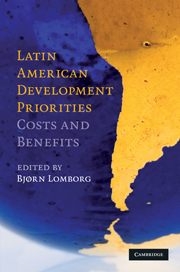Book contents
- Frontmatter
- Contents
- List of figures
- List of tables
- List of contributors
- Acknowledgments
- Abbreviations and acronyms
- Expert panel findings
- Introduction
- Democracy
- Education
- Employment and social security
- Environment
- Fiscal problems
- Health
- Infrastructure
- Poverty
- Public administration
- 9 Public administration and institutions in the LAC region
- 9.1 Public administration: an alternative view
- Violence and crime
- Conclusion
- References
9.1 - Public administration: an alternative view
Published online by Cambridge University Press: 05 June 2012
- Frontmatter
- Contents
- List of figures
- List of tables
- List of contributors
- Acknowledgments
- Abbreviations and acronyms
- Expert panel findings
- Introduction
- Democracy
- Education
- Employment and social security
- Environment
- Fiscal problems
- Health
- Infrastructure
- Poverty
- Public administration
- 9 Public administration and institutions in the LAC region
- 9.1 Public administration: an alternative view
- Violence and crime
- Conclusion
- References
Summary
Introduction
Chapter 9 by Susan Rose-Ackerman is a tour de force. It contains a comprehensive survey of the literature and a careful description of the main challenges for institutional reform in Latin America. Since the chapter is so comprehensive, it is almost impossible to focus on something that was not already mentioned in it and to prepare an alternative view highlighting the chapter's weaknesses.
An easy but, in my view, unfair way to criticize the chapter would be to say that the discussion of solutions to the challenge is short and lacks a detailed CBA. This would be unfair because the challenge that Rose-Ackerman was faced with was almost mission impossible. In fact, I can think of five types of challenges for a project like that of the Copenhagen Consensus. (1) There are challenges for which we know the solution and for which we also know how to estimate their costs and benefits (think about preventing the spread of a disease for which there is a known vaccine). (2) There are also challenges for which we do not know the exact solution but for which we have an idea of what may work well and, if we knew the solution, it would be easy to estimate its costs and the benefits (think about preventing the spread of a disease for which we still do not have a vaccine).
- Type
- Chapter
- Information
- Latin American Development PrioritiesCosts and Benefits, pp. 591 - 620Publisher: Cambridge University PressPrint publication year: 2010



